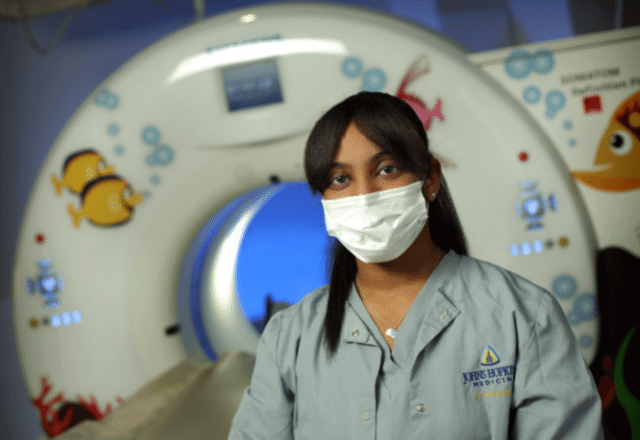Meet Doronella Simon

Doronella Simon started her imaging career at The Johns Hopkins Hospital as an X-ray technologist and continued to grow her skill set by taking advantage of paid on-the-job training for advanced modalities. Now, as a CT technologist, she finds building a solid rapport with patients, often in just minutes, the most rewarding part of her career.
Simon was always interested in health care but wasn’t sure which path to take. After speaking with her college adviser, she enrolled at the Johns Hopkins Schools of Medical Imaging (SOMI) and graduated from the radiography program. That was the first step in her Johns Hopkins career.
How did you become a CT technologist?
Through SOMI, I received training in general X-ray for orthopaedics, pediatrics, emergency room, trauma, mobile studies and the surgical suite at inpatient- and outpatient exam locations. Once I graduated, I immediately took a job with Johns Hopkins Medicine and enrolled in CT (computerized technology) school. My continued education was paid for by Hopkins, and I continued to earn my salary while taking the course. The program took five months, and I was able to learn both in the classroom and in practical opportunities about contrast media, CT principles and instrumentation, and patient care.
What’s your favorite part of being a technologist?
I truly enjoy building a relationship with my patients. I am a very social person, so meeting new people regularly is a strength of mine. I appreciate learning patients’ stories and being a member of their treatment team.
As a CT technologist, I’m not just behind a computer screen. I am speaking to patients, easing nerves and answering questions about the CAT scan procedure.
What does your typical day look like?
I work mainly as an inpatient technologist and occasionally in the emergency department. My day starts by clocking in and re-starting the scanners. We have comprehensive quality control checklists that I perform, and I turn the contrast warmers on for incoming patients. Patients are brought to me and I explain the procedure, answer questions, review our consent questions, have necessary paperwork started, and then the scan begins. I complete the same process for each patient.
What makes your work at Johns Hopkins Medicine different?
Working at such a prestigious hospital allows me to see and work on the rarest of cases. We work in an extremely collaborative environment. My problem-solving skills have been refined, and I’m able to manage situations in and out of the exam room quickly and efficiently.
What is your proudest moment in your radiology career?
Graduating from the Johns Hopkins Schools of Medical Imaging was my proudest moment for sure. It was also an easy decision to work at Hopkins and take advantage of their continued education program. Now that I’ve been at Hopkins for five years, I get to mentor new technologists and share my experiences.
What would you tell a new technologist?
Be prepared for everything! At Hopkins, you will see and experience a lot. I recommend learning to adjust to your environment and to take a step back before making decisions. Don’t hesitate to ask for help. It’s a team environment that is collaborative by nature. We look at things like a stack of Swiss cheese — each layer assists in making sure nothing falls through. It’s a busy environment, but we maintain positive attitudes, and our team feels like family.
